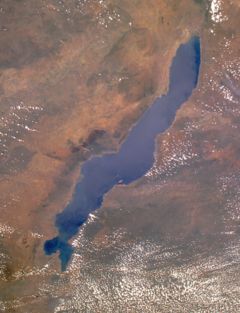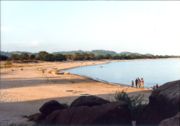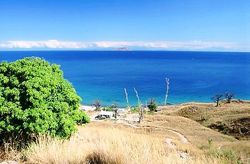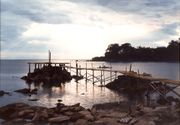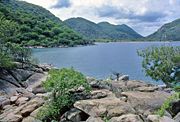Lake Malawi
2008/9 Schools Wikipedia Selection. Related subjects: African Geography
| Lake Malawi | |
|---|---|
|
|
|
| Coordinates | |
| Lake type | Rift lake |
| Primary inflows | Ruhuhu |
| Primary outflows | Shire River |
| Basin countries | Malawi, Mozambique, Tanzania |
| Max. length | 560 km to 580 |
| Max. width | 75 km |
| Surface area | 29,600 km² |
| Average depth | 292 m |
| Max. depth | 706 m |
| Water volume | 8,400 km³ |
| Surface elevation | 500 m |
| Islands | Likoma and Chizumulu |
| References | |
Lake Malawi (also known as Lake Nyasa, Lake Nyassa, Lake Niassa, and Lago Niassa in Mozambique), is the most southerly lake in the East African Rift valley system. The lake, third largest in Africa and ninth largest in the world, is situated between Malawi, Mozambique, and Tanzania. It is also the second deepest lake in Africa but its placid and nature at its northerly shore gives no hint of this feature. The lake's tropical waters teem with more fish species than any other lake on Earth.
Geography
Lake Malawi is between 560 and 579 km long and is 75 km wide at its widest point; its total surface area is approximately 29,600 km². The lake is bordered by western Mozambique, eastern Malawi, and southern Tanganyika, the mainland portion of Tanzania. Its largest tributary is the Ruhuhu and its outlet is the Shire River, a tributary of the Zambezi.
Lake Malawi lies in the rift valley formed by the East African Rift where the African tectonic plate is splitting in two. The lake itself is approximately 40,000 years old.
It is approxiamately 350km south east of Lake Tanganyika.
European discovery and colonization
David Livingstone was the first European to reach the lake, arriving at its shores in 1859 and naming it "Lake Nyasa." Much of the area surrounding the lake was subsequently claimed by the United Kingdom to form the colony of Nyasaland. Although Portugal took control of the eastern shores of the lake, the islands of Likoma and Chizumulu (which lie just off the shore) were colonised by Scottish missionaries from Nyasaland, and as a result were incorporated as part of Nyasaland rather than Mozambique. Today they form lacustrine enclaves: Malawian territory surrounded by Mozambique waters.
On August 16, 1914, the lake saw a brief naval engagement when the British gunboat Guendolen, commanded by Captain Rhoades, heard that World War I had begun and received orders to "sink, burn, or destroy" the German Empire's only gunboat on the lake, the Hermann von Wissmann, commanded by Captain Berndt. Rhoades's crew located the Hermann von Wissmann in a bay near Sphinxhaven, in German East Africa's territorial waters, and disabled it with a single shot from a range of 2,000 yards. The encounter was hailed by The Times as the British Empire's first naval victory of World War I. (Germany had controlled what would become Tanzania up to this point.)
Borders on the lake
The largest part of the lake is in Malawi, while about a quarter of the lake area is under the jurisdiction of Mozambique; this includes the area surrounding the Malawian islands of Likoma and Chizumulu, which are the lake's only two inhabited islands. Likoma is dominated by a huge stone Anglican cathedral, built by missionaries in the early 20th century. A notable feature of both islands is the large number of Baobab trees. The islands support a population of several thousand people, who, besides fishing the waters of the lake, grow cassava, bananas and mangos.
Lake Nyasa or Lake Malawi?
The name of the lake itself is also disputed. Malawi claims the lake is named 'Lake Malawi' while international maps and other countries (most notably Tanzania) claim the name of the lake to be 'Lake Nyasa'. The origins of the dispute in the name have their background in geopolitical disputes that began prior to Malawi's independence in 1964, when it was previously known as Nyasaland.
Further complications emerged for different political reasons in the 1960s, when the then President Banda (of Malawi) became the only African leader to establish diplomatic relations with white South Africa. This was fiercely repudiated by other African leaders, including the then President Nyerere (of Tanzania). The contrasting attitudes and policies gave further impetus to disputes between the two governments, on the name of the lake itself, and the boundary between the two countries.
At present, the dispute between the two governments is largely dormant. Intergovernmental relations between Malawi and Tanzania are largely cordial.
Tanzania-Malawi dispute
The partition of the lake area between Malawi and Tanzania is disputed. Tanzania claims international borders through the lake along the lines of the borders between the German and British territories before 1914; Malawi, meanwhile, claims the whole non-Mozambican lake, including the waters next to the Tanzanian shore. The foundations of the dispute were set when the British colonial government, which had recently captured Tanganyika from Germany, put the water under the jurisdiction of Nyasaland without a separate administration for the Tanganyika portion. The dispute has led to conflicts in the past, though for several years Malawi has declined to enforce its claims to the disputed portion.
Occasional flare-ups in the 1990s and in recent times have impacted fishing rights, particularly of Tanzanians who reside on the lake shore, who have occasionally been accused of fishing in Malawian waters.
Transport
Large-scale transport between settlements along the shores of the lake and between the Malawi shore and Likoma and Chizumulu islands is provided by steamers. The MV Ilala is the best known, although in recent years has often been out of service. When running, it travels between Monkey Bay at the southern end of the lake to Karonga in the north, and occasionally to the Iringa Region of Tanzania.
Boats travel about twice a week from Nkhata Bay on the mainland to Likoma and Chizumulu islands, taking about five hours to cross the lake. Neither island has a usable port, and boats moor offshore before transferring passengers and produce to the shore in small dinghies.
Informal transport between the two islands and from Likoma Island to the Mozambique town of Cobue is provided by small dhows.
Wildlife
Lake Malawi has traditionally provided a major food source to the residents of Malawi as it is rich in fish, the most famous of which are the chambo, consisting of any one of four species of the cichlid genus Nyasalapia, as well as the kampango, a large catfish (Bagrus meridionalis). The fish are an important export for Malawi, but wild populations are increasingly threatened by overfishing and pollution. Other wildlife resident in the lake includes crocodiles, hippopotamuses, monkeys, and a large population of African Fish Eagles which feed off the fish population.
Cichlids
Lake Malawi is famous for its cichlids, popular in the aquarium trade. Malawi cichlidaes are divided into two basic groups, loosely referred to as the haplochromines and the tilapiines. Within the first group (Haplochrominae) there are two subgroups. The first consists of the open water and sand dwelling species whose males sport bright colors while the females show a silvery coloration with sometimes irregular black bars or other markings. The second subgroup is known locally and popularly as mbuna, which means "rockdweller." Mbuna are smaller, and both sexes often showing bright coloration, though in many species the females may be brownish overall.
The second group, the tilapiines, consists of the only substrate-spawning species in the lake ( Tilapia rendalli), as well as the 4 species of chambo (Nyasalapia). Lake Malawi's cichlids from the Haplochromine group are popular in the international aquarium hobby.
Snails
The lake also supports populations of snails, some of which carry bilharzia. For many years this was strenuously denied by the government, which feared it would deter tourism in the area, but since the fall of Hastings Banda (dictator of Malawi from 1961 to 1994), the presence of bilharzia in the lake has been more widely acknowledged. Due to the overfishing of snail-eating cichlids, what little bilharzia that existed increased to the point of being a hazard to bathers in the south east portion of the lake.
Water chemistry
The water in lake Malawi is typically alkaline with a pH of 7.7 – 8.6, a carbonate hardness of 107 – 142 mg L-1 and a conductivity of 210 – 285 µS cm-1. The lake water is generally warm, having a surface temperature that ranges from 24 – 29 ° C (75 – 84 ° F) and a deep level temperature of 22 °C (71.6 °F).
